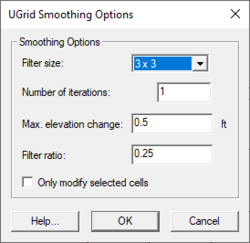SMS:Quadtree Module
The Quadtree Module contains tools used to construct and edit Quadtrees. A quadtree is a tree data structure in which each internal node has exactly four children. Quadtrees are most often used to partition a two-dimensional space by recursively subdividing it into four quadrants or regions.
In SMS, Quadtrees are synonymous with telescoping grids because currently only the CMS-Flow model can utilize them and they are referred to as telescoping grids by that model and its developers. Since SMS version 12 does not include the interface for the new version of CMS-Flow, this article is only a skeleton and will be filled in as that interface is released.
It is strongly recommended that quadtrees be created through the Map Module. The quadtree module currently includes interfaces for:
- CMS-Flow – hydrodynamic circulation specifically adapted for coastal zone
Creating and Editing Quadtrees
Creating Quadtrees
A Quadtree is generated using a Quadtree Generator coverage and uses a technique from previous versions of SMS to generate telescoping grids. The rules for generating such a grid are described in the Telescoping Grid article.
The Map → Quadtree command is used to create a quadtree.
Map → Quadtree
The Map → Quadtree command is used to construct a quadtree grid using a grid frame feature object in a the current quadtree generator coverage. When the Map → Quadtree command is selected, the Map → Quadtree dialog appears.
Parameters specified to create the grid include:
- Grid Geometry – This section allows the user to specify the origin, orientation and size of the grid. The fields of these quantities are populated with default values based on the three points. The orientation is measured as an angle from the positive X axis.
- Cell Options – This section allows the user to specify the number of cells in each direction in the grid. Several options are available. The user can specify sizes in the I (Delta U)and J (Delta V) directions or a number of columns and rows. If the Use Grid Frame Size toggle is checked, the grid will exactly match the dimensions specified in the Grid Geometry section. If that option is not checked, the last row and column may extend beyond the specified lengths. This allows the user to specify exact grid size, or exact cell size.
- Depth Options – The elevations or depths assigned to each cell or node can be specified as a single value, or the user may select a dataset to interpolate from.
SMS will generate a quadtree on the input parameters.
Editing Quadtrees
Each of the cells in a quadtree can be subdivided into four subcells by selecting the cell, right-clicking, and selecting the Split command. Multiple cells may be selected and split in a single command.
Four sub cells can be merged by selecting them, right-clicking, and selecting the Merge command.
Smoothing Quadtrees
It may be useful to smooth the spatial data stored on a quatree for a number of reasons. These reasons include:
- In order to conserve the amount of disk spaced required to store a DEM, many DEM formats store elevations rounded to the nearest integer value. This causes elevation changes to occur in discrete steps rather than smoothly, as would be the case in nature. In regions of low relief, rounded elevations can cause an area to be artificially "flat."
- Surveys may include anomalies. Smoothing algorithms blend these bad data points into the surrounding values.
- Datasets may include spurious noise either from physical conditions such as waves or numerical filtering. Smoothing can dampen these variations.
When right-clicking on the quadtree in the Project Explorer, operations for the quadtree appear in a pop up window. One of these is the smooth operation.
Quadtree Smoothing Options
The Quadtree Smoothing Options dialog contains the following options:
Converting Quadtrees
Quadtrees may be converted to other types of data used in SMS, such as a Scattered Dataset of 2D mesh. Quadtrees can be converted by right-clicking on the grid in the Project Explorer.
Project Explorer
The following Project Explorer mouse right-click menus are available when the mouse right-click is performed on a Quadtree item. See Quadtree Menus for more information.
Quadtree Module Tools
See Quadtree Module Tools for more information.
Quadtree Module Menus
See Quadtree Module Menus for more information.
How do I?
To learn more about how to use the Quadtree Module go to the Tutorials section of the Aquaveo website at: http://www.aquaveo.com/software/sms-learning-tutorials.
Related Coverages
The grid module currently includes interfaces for:
- CMS-Flow – hydrodynamic circulation specifically adapted for coastal zone
Related Topics
SMS – Surface-water Modeling System | ||
|---|---|---|
| Modules: | 1D Grid • Cartesian Grid • Curvilinear Grid • GIS • Map • Mesh • Particle • Quadtree • Raster • Scatter • UGrid |  |
| General Models: | 3D Structure • FVCOM • Generic • PTM | |
| Coastal Models: | ADCIRC • BOUSS-2D • CGWAVE • CMS-Flow • CMS-Wave • GenCade • STWAVE • WAM | |
| Riverine/Estuarine Models: | AdH • HEC-RAS • HYDRO AS-2D • RMA2 • RMA4 • SRH-2D • TUFLOW • TUFLOW FV | |
| Aquaveo • SMS Tutorials • SMS Workflows | ||
